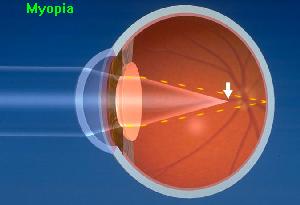The Nearsighted Eye
Approximately one in four Americans is nearsighted,
totalling 70 million people. The degree of myopia can vary from low (-1 to -3 diopters) to
high (greater than -6 diopters). Myopia is not caused by reading at an early age,
prolonged reading, reading in the dark, watching TV too closely, wearing glasses too
strong, wearing glasses too weak, or other similar activities. Some controversy exists
over whether myopia can be made worse be prolonged near work as a child, but this has
never been proven.
 |
In a nearsighted eye, the
cornea is too steeply curved for the length of the eye, causing light rays to focus in
front of the retina. Distant objects appear blurred or fuzzy because the light rays are
not in focus by the time they reach the retina. In this picture, the arrow shows the focus
of the nearsighted eye while the dotted lines represent the path of light rays in the
normal eye. The greater the myopia, the more the light rays converge and the more
blurred distant objects are. |
Some studies have correlated myopia with higher I.Q.s., but
this probably has to do with the fact that myopes tend to read more since that's where
they can see the best without glasses (see below). Myopia tends to run in families, so it
is probably inherited--at least to some extent. Myopia tends to begin in the early teens
(earlier for high myopes), and it usually increases as the eye grows in length during
puberty. It tends to stabilize after age 18.
Near objects, viewed at the proper distance, can be seen
clearly because the focus of their light rays matches the refractive error of the
nearsighted eye. For example, a patient with -2 diopter correction is naturally in focus
at 0.5 meters (18 inches). Having the focus point of the eye within arm's length is an
intrinsic advantage to the low myope, who always has the option of seeing well at near
without optical correction. Indeed, many myopes instinctively remove their spectacles for
near work, particularly after the onset of presbyopia.
Spectacle Correction:
The correction of myopia with spectacle lenses creates both
advantages and disadvantages for the myope. The obvious advantage is bringing distant
objects into focus. The disadvantages increase in rough proportion to the strength of the
lens. Most myopes begin wearing spectacles in childhood and therefore incorporate the less
desirable cosmetic, convenience, and optical disadvantages into their daily routine;
however, this adaptation varies among individuals.
Among the optical drawbacks of spectacle lenses that
correct myopia is minification of the image. There is about a 2% minification for every
diopter of spectacle power. For example, a -10 diopter spectacle correction results in
about a 20% reduction in image size. Thick lens edges and supporting frames also distort
and reduce the peripheral vision.
Contact Lens Correction:
Contact lenses reduce the optical problems associated with
spectacle lenses, but they have their own unique problems including the need for
cumbersome care solutions, corneal warpage, corneal hypoxia (lack of oxygen), corneal
infections, and eyelid allergies. Some people lose their ability to wear contact lenses -
particularly those who have dry or sensitive eyes. It is typical for contact lens
intolerance to occur at about the age of 40.
